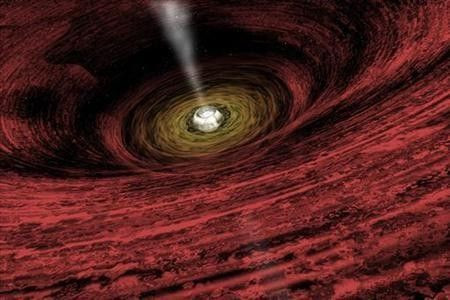Black hole rips apart Sun-like star in impulsive once-in-million-year feeding frenzy

A hungry black hole far out in the cosmos, about 4 billion miles from Earth, got into an unusual feeding spree when a massive Sun-like star crossed its path, or to be accurate, passed by its gravitational sphere.
The massive star was ripped apart, shredded into pieces as the giant black hole devoured it, unleashing some of the most powerful gamma ray flashes astronomers have ever seen. For the black hole, this type of unusual feeding spree happens only once in a million years, astronomers say.
Scientists learned how the black hole ate up the sate after they noticed an unusual months-long emission of powerful radiation moving towards Earth, which was emitted by the dying star.
It was NASA’s Swift Gamma Burst Mission spacecraft that first detected the gamma-ray flash, called Sw 1644+57. It was spotted within the constellation Draco, at the center of a galaxy nearly 4 billion light-years away, according to space.com.
Joshua Bloom, assistant professor of Astronomy at University of California, Berkeley, explained how the scientists were able to detect the unabashed eating up of a star by the hungry black hole.
Astronomers had first detected the intensely bright flash deep in the cosmos, but they initially thought it was a powerful burst of gamma rays from a collapsing star. But the tremendous amount of energy could still be seen months later, promoting more studies which led to the conclusion that that the strange beam of energy came when a star was being ripped apart by a massive black hole.
This burst produced a tremendous amount of energy over a fairly long period of time ... That's because as the black hole rips the star apart, the mass swirls around like water going down a drain, and this swirling process releases a lot of energy, Bloom told space.com.
Astronomers say the black hole gobbled up the star in an impulsive act, contrary to the recorded pattern of behavior of black holes in that area o the cosmos.
We have this otherwise dormant black hole, not gobbling up an appreciable amount of mass, and along comes this star which just happens to be on some orbit which puts it close to the black hole, Bloom told Reuters.
This was a black hole which was otherwise quiescent and it sort of has an impulsive feeding frenzy on this one star.
This sudden pang of hunger is not a trait associated with black holes, which suck in anything in its gravitational field and lets nothing escape from it, not even light.
Another astronomer confirms that the cosmic event was nothing other than a giant black hole ripping apart a massive star and eating it up, releasing a mighty jet of energy towards Earth in the process. Andrew Levan of the University of Warwick in the U.K. says this event seemingly happened right in the center of the galaxy.
“The best explanation that so far fits the size, intensity, time scale, and level of fluctuation of the observed event, is that a massive black hole at the very center of that galaxy has pulled in a star and ripped it apart by tidal disruption ... The spinning black hole then created the two jets, one of which pointed straight to Earth.”
© Copyright IBTimes 2025. All rights reserved.





















